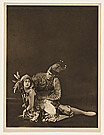L'Oiseau de Feu [Firebird]
Fantastic ballet in one act
- Producer: Les Ballets Russes de Serge Diaghilev
- Premiere: 25 June 1910, Théâtre national de l’Opéra, Paris
- Revival: 25 November 1926, Lyceum Theatre, London
- Costume design: 1910 Aleksandr Golovin and Léon Bakst;
1926 Natalia Goncharova - Costumier: Vera Sudeikina (for 1926 revisions)
- Scenery design: 1910 Aleksandr Golovin and Léon Bakst;
1926 Natalia Goncharova - Music: Igor Stravinsky
- Choreography: Michel Fokine
- Libretto: Michel Fokine, from a Russian folk tale
- Main characters: The Firebird, (Prince) Ivan Tsarevitch, Köstchei the Immortal, Tsarevna, the Enchanted Princesses, the Kikimoras
During a night-time hunt near the ancient castle of the evil wizard, Köstchei the Immortal, Prince Ivan captures the enchanted Firebird, half woman and half bird. In exchange for her freedom the Firebird gives Ivan one of her magical feathers and promises to protect him if ever he needs help. Twelve young princesses, enslaved by the sorcerer, approach the castle gates revelling in their one hour of freedom each dawn. During this hour Ivan and Tsarevna, one of the princesses, fall in love. On her return to the castle, the prince attempts to follow her inside. Köstchei and his entourage of monster guards attack him. Prince Ivan brandishes the Firebird’s feather which calls her forth, and together they destroy the wizard and his brigade, freeing the princess. The ballet ends with the extravagant wedding party of Ivan and Tsarevna where the prince is crowned king of the realm.
Steeped in the Russian folk art and craft revival during his membership of the Abramtsevo and Talashkino groups, the designer Alekandr Golovin became an active participant in the exhibitions and projects of the miriskusniki before being commissioned by Diaghilev to design his 1908 opera, Boris Godunov. His following commission, L’Oiseau de feu, an amalgam of several Russian folk tales developed by Benois and Fokine, was set in the overgrown and sinister garden of Köstchei’s palace, stimulating Golovin to design a rich and decorative Symbolist décor. His costumes were influenced by the traditional Slavic festival costumes worn by both men and women, with white belted tunics stencilled in pale colours with patterns simulating the richness of traditional brocades and braids. Hooped overdress hems were layered over tunic underskirts, giving a floating otherworldliness to the costumes. Despite Golovin’s completely integrated design schema for this production, Diaghilev was dissatisfied with the costumes for the Firebird, Tsarevna and Ivan Tsarevich, and commissioned Léon Bakst to redesign them. Diaghilev revived the ballet in 1926, commissioning Natalia Goncharova to design new sets and costumes, some of which were modified from the 1910 originals by the addition of different trims and appliqué materials. Golovin’s original backdrop was used by the Monte Carlo Russian Ballet for its revival production of The firebird at His Majesty’s Theatre in Melbourne in November 1936.
L’Oiseau de feu entered the canon of twentieth-century music as The firebird, Igor Stravinsky’s breakthrough ballet score, and the later suites he developed from it.
This was the first original score commissioned by Diaghilev for the Ballets Russes and signalled the start of the impresario’s lifelong close professional relationship with Stravinsky, and of the composer’s career. His extraordinary music for this production was seen as a crucial but equal element of its unique visual, aural and balletic structure, prompting the French critic, Henri Ghéon, to write:
The old-gold vermiculatino of the fantastic back-cloth seems to have been invented to a formula identical with that of the shimmering web of the orchestra. And as one listens, there issues forth the very sound of the wizard shrieking, of swarming sorcerers and gnomes running amok. When the bird passes, it is truly the music that bears it aloft. Stravinsky, Fokine and Golovin, in my eyes, are but one name.2






![Aleksandr GOLOVIN | Costume for one of Köstchei's women [femmes de Köstchei] | c.1910](images/sml/148211.jpg)







